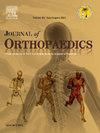在皮隆骨折切开复位内固定中,腓骨内固定与较高的伤口并发症发生率无关
IF 1.5
Q3 ORTHOPEDICS
引用次数: 0
摘要
关于腓骨固定治疗枕部骨折的指征,目前还缺乏共识。复位腓骨骨折有助于恢复侧柱长度和复位胫骨平台。然而,理论上存在对伤口并发症和软组织损伤的担忧。本研究的目的是通过一个经过验证的国家数据库,比较胫骨平台ORIF加腓骨固定和不加腓骨固定后的短期疗效。材料和方法利用美国外科医师学会NSQIP数据库,分别使用现行程序术语(CPT)代码27827和27828,对2015年1月1日至2020年12月31日期间接受胫骨平台ORIF(有或没有腓骨固定)的所有患者进行识别。开放性骨折和同时进行开放性手术的病例被排除在分析之外。比较两组之间的人口统计数据、医疗合并症、手术变量和各种30天结果测量。使用多元逻辑回归来确定与各种感兴趣的结果测量相关的自变量。结果最终队列共纳入3120例患者:1530例患者单独接受胫骨固定,1590例患者同时接受胫骨和腓骨固定。腓骨辅助固定组的再手术率(2.3%比1.1%,p = 0.013)和非家庭出院率(14.8%比11.2%,p = 0.003)均较高。手术部位感染率组间比较。补充腓骨固定与计划外再手术独立相关(RR: 1.939 [1.081-3.477], p = 0.026)。结论在胫骨平台ORIF中行腓骨辅助固定的患者30天再手术率和非家庭出院率较高。pilon骨折ORIF期间补充腓骨固定与较高的30天再手术率独立相关。两组手术部位感染和创面裂开的发生率无差异。证据水平3。本文章由计算机程序翻译,如有差异,请以英文原文为准。
Fibula fixation is not associated with a higher rate of wound complications during pilon fracture open reduction internal fixation
Introduction
There is a lack of consensus regarding indications for fibula fixation in pilon fractures. Reduction of the fibula fracture can assist with restoring lateral column length and reduction of the tibial plafond during pilon ORIF. However, there are theoretical concerns with wound complications and soft tissue insult. The purpose of this study is to compare short-term outcome measures after tibial plafond ORIF with and without supplemental fibula fixation using a validated national database.
Materials and methods
The American College of Surgeons' NSQIP database was utilized to identify all patients undergoing tibial plafond ORIF with and without fibula fixation between January 1, 2015 and December 31, 2020 using Current Procedural Terminology (CPT) codes 27827 and 27828, respectively. Open fractures and cases with concurrent open procedures were excluded from analysis. Demographic data, medical comorbidities, surgical variables, and various 30-day outcome measures were compared between the two groups. Multivariate logistic regression was used to identify independent variables associated with various outcome measure of interest.
Results
A total of 3120 patients were included in the final cohort: 1530 patients underwent tibia fixation alone and 1590 patients underwent both tibia and fibula fixation. The supplemental fibula fixation group had a higher rate of reoperation (2.3 % vs. 1.1 %, p = 0.013) and non-home discharge (14.8 % vs. 11.2 %, p = 0.003). The rate of surgical site infection was comparable between groups. Supplemental fibula fixation was independently associated with unplanned reoperation (RR: 1.939 [1.081–3.477], p = 0.026).
Conclusions
Patients undergoing supplemental fibula fixation during tibial plafond ORIF had a higher rate of 30-day reoperation and non-home discharge. Supplemental fibula fixation during pilon fracture ORIF was independently associated with a higher rate of 30-day reoperation. There was no difference in the rates of surgical site infection or wound dehiscence between the two groups.
Level of evidence
3.
求助全文
通过发布文献求助,成功后即可免费获取论文全文。
去求助
来源期刊

Journal of orthopaedics
ORTHOPEDICS-
CiteScore
3.50
自引率
6.70%
发文量
202
审稿时长
56 days
期刊介绍:
Journal of Orthopaedics aims to be a leading journal in orthopaedics and contribute towards the improvement of quality of orthopedic health care. The journal publishes original research work and review articles related to different aspects of orthopaedics including Arthroplasty, Arthroscopy, Sports Medicine, Trauma, Spine and Spinal deformities, Pediatric orthopaedics, limb reconstruction procedures, hand surgery, and orthopaedic oncology. It also publishes articles on continuing education, health-related information, case reports and letters to the editor. It is requested to note that the journal has an international readership and all submissions should be aimed at specifying something about the setting in which the work was conducted. Authors must also provide any specific reasons for the research and also provide an elaborate description of the results.
 求助内容:
求助内容: 应助结果提醒方式:
应助结果提醒方式:


